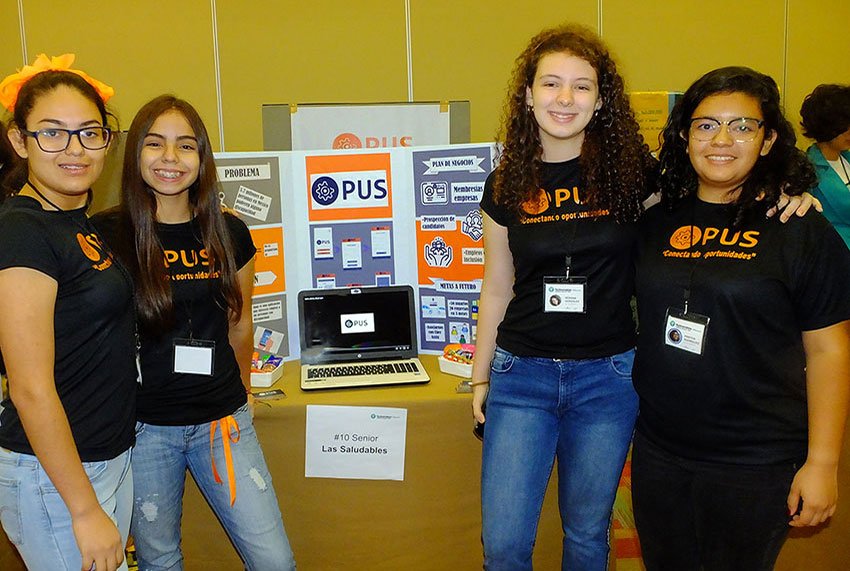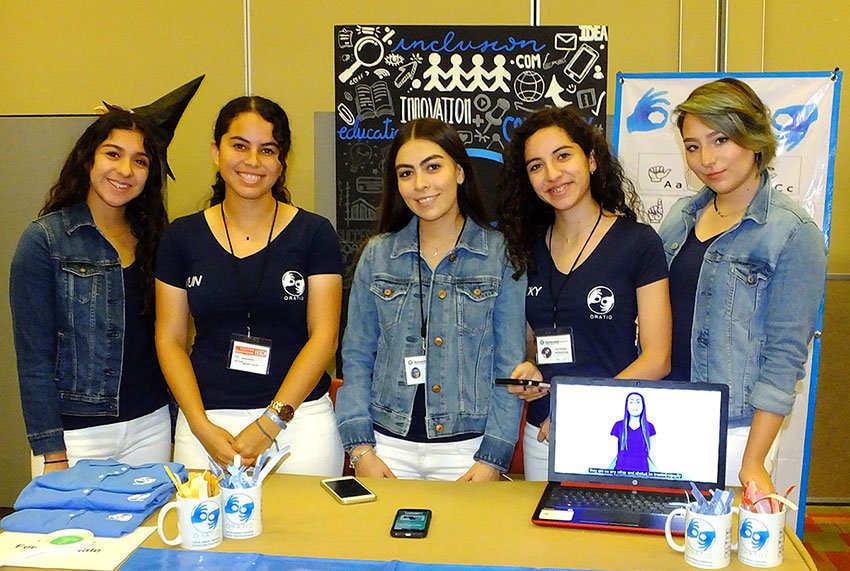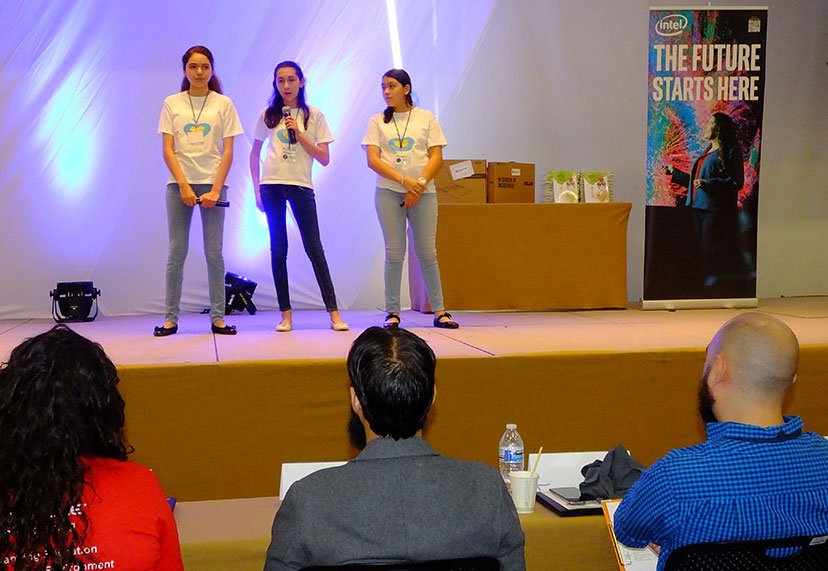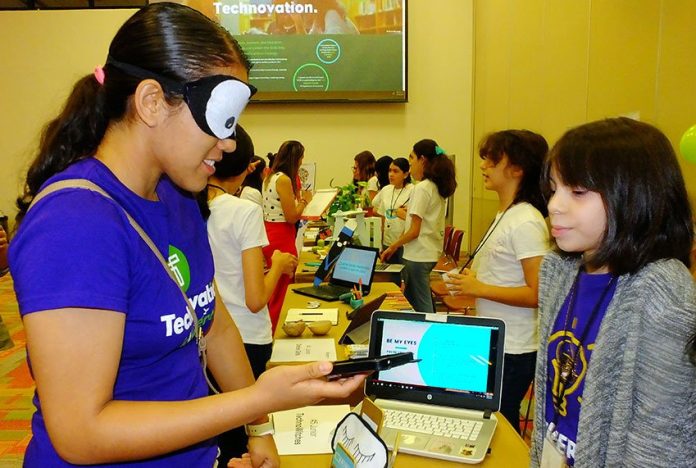Technovation is the world’s largest program aimed at introducing girls aged 10 to 18 to technology entrepreneurship.
It is promoted by the global non-profit organization Iridescent and it is entirely free. It is supported by well-known companies like Google, Oracle, Adobe, Uber and Samsung and is endorsed by the likes of UNESCO and even the U.S. Peace Corps.
But I bet you have never heard of it, and you might wonder why, last year, 20,000 girls from 115 countries took part in it. What could possibly entice kids to spend hours of their free time, on weekdays and weekends, over a period of three to five months, learning computer programming and business skills?
I am in Guadalajara, Mexico, and I aim to find out. Mexico has been participating in Technovation for six years and every year more girls from more Mexican states have opted to participate. Now, June 29, 2019, the first national Technovation competition is being held at a large hall at Monterrey Tec University.
The room is bustling with activity. Along one wall 12 small stands are lined up and at all of them, small teams of girls are demonstrating their creations to anyone interested. By now I know that each of these teams has created an app, a little program that works on a smartphone.

Although I am one of the world’s most reluctant users of smartphones, I am open to learn something new, so I pick a stand at random and walk right up to the five girls standing there.
“Buenos días, I understand you girls have invented an app . . . can you tell me about it?”
“Of course,” says Oriana Hernández. “We’re all from the state of Guanajuato and we’ve developed an app called Oratio, which means ‘speech’ in Latin. This app makes it possible for you to communicate with someone who is deaf, but knows Mexican sign language. So, you could use it to say hello to a deaf person or ask a question. And our app also has a very nice teaching component so you can actually use it to learn how to sign.
“However, I should mention that there are lots of varieties of sign language around the world and we hope to expand our app so it could be used in other countries.” Another of the girls, Alma Yunuen, adds: “We developed this particular app because we felt people with hearing disability are marginalized in our society. Only 12% of the deaf ever have a chance of going to school in Mexico.”
The team I am talking to is called Femme Fatale. They tell me they’ve been working on their project for five months. “We knew absolutely nada about programming when we started and now we have our own app! And we learned all kinds of other things along the way, for example how to organize ourselves and how to work as a team.”
All of the teams present here today have been assisted right from the get-go by several volunteers who act as mentors. As I stepped away from the Oratio booth, I literally bumped into one of them. Her name was Martha Elena Rodríguez, from San Luís Potosí.

“I really like being a mentor,” she told me. “It’s the second time I’ve done it. This time I’ve been working with girls who developed an app which acts as a job center for the disabled. For me, it was a wonderful experience simply to be with these girls and to watch them grow. We mentors teach them something, but they also learn a lot entirely on their own. You can’t imagine how beautiful it is to see them here today, all self-confident, explaining everything they’ve learned to other people. I should also mention that I am one of four mentors for this group and I’ve personally learned a great deal from the other three!”
By chance, the next team I walk up to is from San Luis Potosí. They call themselves TechnoWitches and there are only two members on the team. One of them, Sarahí Alonso, who couldn’t be much more than 10 years old, tells me that their app is called Be My Eyes and it helps the blind get around and solve various problems.
“What?” I blurt out. “How can they use a mobile if they can’t see?” Well, I quickly get put in my place. I learn that their app employs something called Google Talkback which, indeed, is designed to make it easy for the blind to use a smartphone. Through voice commands, Be My Eyes helps the blind use their phone’s GPS to get where they want to go — and not only that. The program cleverly makes use of the camera. Let’s say the blind person wants to know what’s across the street: is the bank that they’re trying to get to over there? Well, explained Sarahí, all they have to do is take a picture and listen to an oral description of what’s in the photo.
“Why did you choose an app to help the blind?” I asked Sarahí.
“When I was little, my mom took me to Diálogo en la Oscuridad (Dialogue in the Dark) where we experienced what it is like to be blind. We had to do a lot of things in total darkness, like go buy something in a pharmacy and by the time it was all over, we realized just how difficult it is simply to walk down the street when you are blind. Now I have a chance to help those people.”
After an hour, it was time for “the pitch event” in which the 12 teams would compete for the national prize. With the help of visuals on giant screens, each team of girls had only a few minutes to get up on the stage to tell the audience all about their app and to answer questions — some of them tough — by a panel of judges from tech companies like Oracle and HP.

In the end, the winning team turned out to be Femme Fatal from Guanajuato, the first group I had interviewed.
“Their prize,” coordinator María Makarova told me later, “is a trip to San Francisco where the Technovation world pitch event will take place. They will visit the Silicon Valley companies, meet girls from all over the world and spend a whole week in the Bay Area.”
“After the event,” Makarova continued, “we all went out to dinner together and what were most of the girls doing throughout the meal? They were using the two apps from this competition that teach you how to use sign language and they were actually communicating with girls on the other side of the room. It was beautiful!”
Schools all over the world try to get girls interested in science, often without much luck. How, I asked myself, does Technovation succeed in this so brilliantly? To find out, I first looked into the origin of the Technovation Challenge. I learned it was founded in 2009 by Anuranjita Tewary, a data scientist who was so impressed by her experience at a startup weekend that she developed a method to recreate that same experience for young girls.
I had no idea what a startup weekend was, but quickly learned that it’s a three-day event for business people who form teams, work with mentors, develop a business plan, engineer a demo product and pitch their idea to others. At the end there is a competition and prizes for the best project. Said Dr.Tewary: “I want every girl and every woman to have that confidence that they can lead, that they can create something out of nothing.”
Perhaps the key word here is “create.” Force kids to study what’s in a textbook and you get boredom. Challenge them to create something out of nothing and you get learning.
[soliloquy id="83312"]
The writer has lived near Guadalajara, Jalisco, for more than 30 years and is the author of A Guide to West Mexico’s Guachimontones and Surrounding Area and co-author of Outdoors in Western Mexico. More of his writing can be found on his website.
